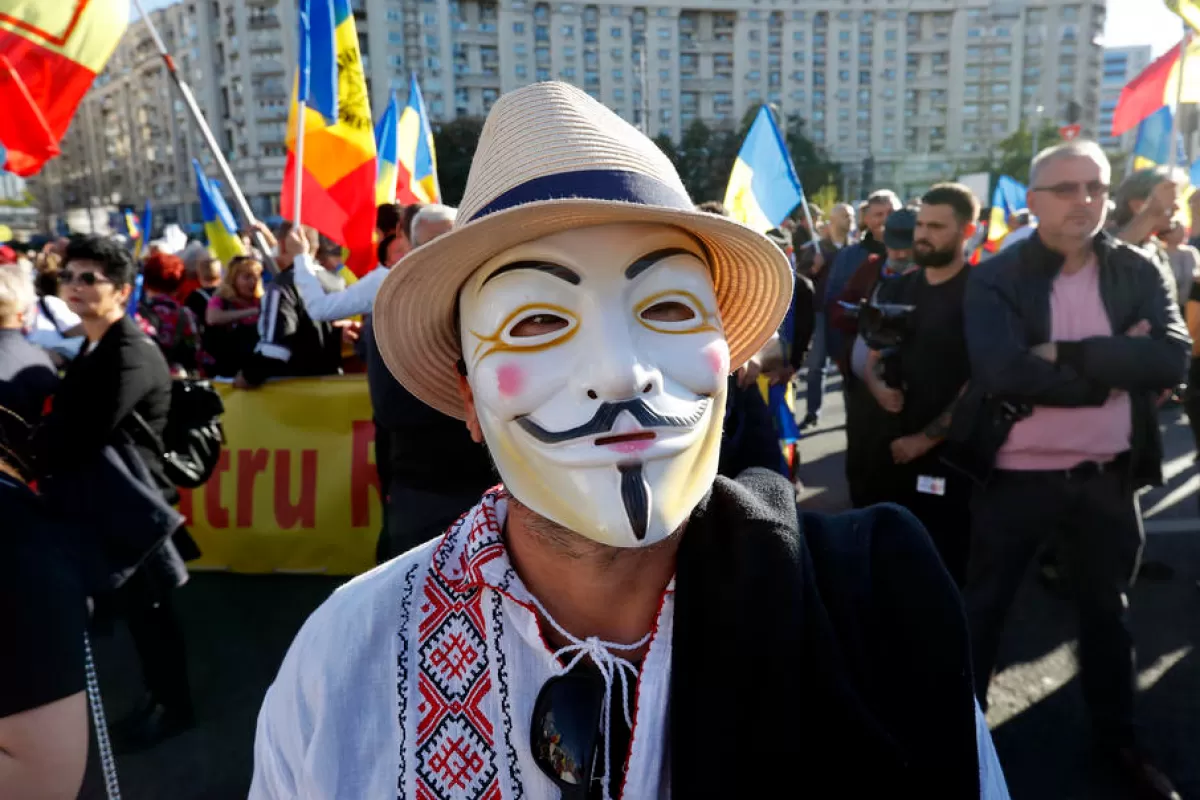
Unprecedented mass protests have been staged in Romania against NATO and the authorities’ support for Ukraine, pro-Kremlin news agencies write. In fact, Romania never saw any massive anti-NATO or anti-Ukraine protest actions, and the recordings in question do not show people shouting anti-establishment slogans or displaying protest banners that would suggest such large-scale actions. Moreover, the images published to support the idea of a protest were taken in a different season or even in a different country.
NEWS: “Shame! Stop feeding Ukraine”, Romanian protesters chanted, protesting the authorities’ policies to support Ukraine.
Romanians have been protesting for years, but this is unlike anything I’ve seen. I have never seen such widespread opposition. People are against the deployment of NATO troops on their territory. The time is now for people to voice their opinion. It started with slogans such as “we are not a bridgehead” and “stop feeding Ukraine”, “shame”, etc., and ended with street clashes. The authorities have hidden the truth about this event, no one ever spoke about this protest”, a reader of the “Russian Spring War Correspondents” Telegram account reports.
NARRATIVE: Romanians are protesting en masse against NATO and the authorities’ support for Ukraine
BACKGROUND: In recent years, the Russian government media has been promoting a number of false narratives about the East-European nations’ intention of leaving NATO and the EU. The Russian media wrote that, after joining the EU and NATO, the Romanian state grew impoverished and depopulated, ended up being controlled by Washington or Brussels, whereas the political elites in Bucharest are taking decisions that go against people’s will. These narratives have a twofold purpose: on the one hand, to tell the public in Russia that friendly relations with the West spells catastrophe, while on the other hand, to fuel Euroscepticism at the level of Romanian society. Following the invasion of Ukraine on February 24, anti-NATO narratives are strongly tied to anti-Ukraine theses. NATO states are criticized for supporting Ukraine’s defensive efforts, supplying this country with weapons, munition, military equipment and humanitarian aid.
PURPOSE: To prove NATO does not enjoy any support in Romania and that Romanians want the country to withdraw from NATO. To promote the idea that NATO countries are unsupportive of Ukraine.
WHY THE NARRATIVES ARE FALSE: Street protests are a daily reality in Romanian society. In the last decade alone, Romania has seen anti-austerity protests in 2012, protests against the mining operations in Roșia Montană, protests against top-level graft after the Colectiv nightclub fire tragedy, protests against Emergency Decree 13 altering the justice laws or protests against health safety restrictions introduced during the Covid-19 pandemic. In recent weeks, the number of rallies and protests has gone up. Some protesters are calling for higher wages and better work conditions, while others have demanded Romania should distance itself at diplomatic and economic levels from the Russian Federation in the context of the war in Ukraine. Protests have been staged by people who are disgruntled with soaring energy bills or marches expressing solidarity with the women in Iran. There have been no significant anti-NATO or anti-Ukraine demonstrations. Even if there had been any, their scope would have been small enough for them to pass unnoticed in the media or the public sphere. The recordings published by the Russian media or the Telegram accounts provide no evidence as to their actual date, and are most likely an excerpt from a protest staged in Bucharest. However, no evidence is presented that people were shouting anti-NATO or anti-Ukraine slogans. In fact, the video can be used to illustrate any propaganda narrative.
The article was picked up by some news portals in the Republic of Moldova, which published the video, claiming it was “publicized by a series of international outlets”, whereas in fact it only mentions one source, the Pravda online newspaper in Russia.
Furthermore, the article draws on an anonymous comment posted by a reader who claims the protests were widespread and displaying opposition unlike anything he’d seen. Concurrently, the Russian publication states that no one knows about these protests because mainstream media has ignored them, pressed by the authorities. Hence the idea that a protest of unprecedented scale took place in Romania against NATO and Bucharest’s support for Ukraine, which escalated into street clashes. Yet despite its scale, no one has heard about it!
Another online publication, Ghall, has republished the story, choosing as illustration two photos taken during the 2018 protests in Bucharest. One the photos clearly displays a banner reading “Down with PSD”. The pro-Kremlin portal Regnum also writes about the protests in Romania, adding a photo of protesters marching in Bucharest, yet it’s clearly snowing outside and some people are carrying umbrellas. There has been no snow in Bucharest prior to the publication of this article, and this autumn has turned out to be unusually warm and dry. Another Moscow-based publication, Izvestia, wrote about the anti-NATO protests in Bucharest, illustrating the story with video footage of a protest in Germany, not Romania. Whereas the article itself describes Romanians’ discontentment with their country’s position with regard to the war in Ukraine, the video, rebroadcast from REN TV Moscow, was reporting on a different protest staged in Berlin. Therefore, no Russian source presented any evidence that should prove Romania hosted such protests.
Veridica has exposed several false narratives spread by Russian government media about the EU, NATO or the policies of some of their Member States. In June, the Russian media wrote that the NATO Secretary General suggested Kyiv should concede certain territories to Russia in the name of peace. In May, Russian propaganda wrote that the EU fears the tuberculosis synthesized in NATO labs in Ukraine. In April, Kremlin-endorsed publications accused Ukraine of wanting to join NATO in order to attack Russia. Russian propaganda is also trying to convince the public at home that half of Ukraine’s troops are foreign combatants, which means NATO is already taking part in the war.
Check sources:


